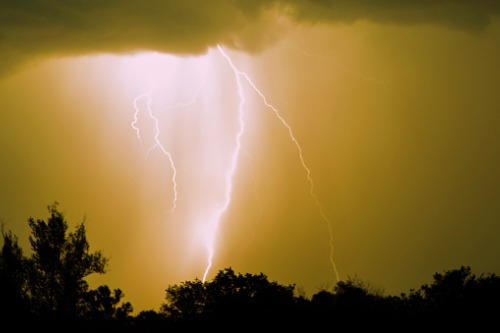A FloodFlash primer on Severe Convective Storms

As we look towards spring, snow melt isn’t the only cause of flooding. March represents the beginning of the peak Severe Convective Storm (SCS) season. SCS has become a focus for insurers and brokers over the last few years, so we thought we’d share some insights on SCS so you are better prepared to support any clients at risk.
What are Severe Convective Storms?
The production of SCS happens when hot and moist air travels vertically in the atmosphere mixing with the cooler air above to form ominous clouds in large towers or plumes, called cumulonimbus clouds. These clouds are more commonly known as thunderclouds. It’s not just thunder and lightning that they bring. SCS are severe local storms associated with thunder and lightning, yes, but also heavy rain, hail, strong winds, tornados, and sudden temperature changes.
Severe Convective Storms bring thunder and lightning, along with heavy rain and strong winds.
What factors contribute to Severe Convective Storms?
According to the Royal Meteorological Society, three factors are required for SCS to take place: instability, moisture and lift. Instability occurs when the rising parcel of air is warmer than its surroundings. As this parcel cools it produces moisture. The final piece of the puzzle, lift, can come in various forms. The sun heating the surface of the earth, warm air travelling over raised ground like mountains or instability within a weather front. Any of these factors can intensify or combine to make the resulting storms more severe.
Where is most exposed to Severe Convective Storms?
Severe Convective Storms are often highly localised and can happen with very little warning. States in the Midwest, Southeast, Mid-Atlantic, and Northeast of the US are generally most exposed to SCS risk. However, the impacts can be felt elsewhere in the US and around the world.
Whilst there may not be as many huge storms in the same way that Hurricane losses are widespread, the cost of SCS in these areas can quickly mount up. As Aon noted in their Catastrophe Insights Report for 2023: “while only three severe convective storm events ranked among the top 10 individual economic losses of 2023 and none of them surpassed $10 billion, the peril was responsible for more than $94 billion in combined damage.”
Cumulative global economic losses by peril in 2023. SCS surpassed flooding in terms of the cumulative number of billion-dollar events for the first time. [Source: Aon]
Will climate change have an impact?
According to Aon, there is little to indicate that SCS has been impacted by climate change to date. The reason losses from SCS losses have increased in the last 30 years is mainly due to exposure growth. However, one of the main concerns with our warming atmosphere is to do with the moisture component of SCS. As the atmosphere heats, our air can hold more moisture. According to the Royal Meteorological Society, every degree Celsius of warming, the atmosphere can accommodate up to 7% more water vapour. More water in the atmosphere means more precipitation and worse storms.
The expert view
FloodFlash Catastrophe Risk Analyst Henry Bellwood says: “Severe Convective Storms (SCS) are one of the key contributing perils to insured losses in the US, exposing the highest number of Americans of any natural peril. They can occur as frequent localised events exposing small areas to extreme intensities or as large scale ‘catastrophic’ events.”
“Planetary scale phenomena such as jet streams combine with specific atmospheric conditions determining the region amongst Earths atmospheric layers the storm forms within, and hence crucially the resulting sub-peril. Tornados, gusts, thunder and hail are some of the most violent, but flash floods are the more frequent peril of such a storm. Flash flooding is also the most difficult SCS sub-peril to forecast and model. It poses a significant risk to people all over the US, particularly in urban areas or paradoxically in regions of drought. Many who don’t consider themselves at risk of flooding can experience such events, that often occur quickly with little notice.”
Authored by FloodFlash





